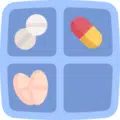Author(s)
Jennifer Pruskowski, PharmD, BCPS, BCGP, CPE
Reviewed By
Brittany Schmidt, PharmD, BCACP
Kathleen Pincus, PharmD, BCPS, BCACP
Halliday BP, Wassall R, Lota AS, et al. Withdrawal of pharmacological treatment for heart failure in patients with recovered dilated cardiomyopathy (TRED-HF): an open-label, pilot, randomised trial. Lancet 2019; 393: 61-73.
The Problem
Dilated cardiomyopathy (DCM) is the leading cause of sudden cardiac death and heart failure (HF) and the chief indication for cardiac transplantation.1 While cardiac modeling has long been considered the hallmark of DCM, approximately 40% of patients see an improvement in left ventricular ejection fraction (LVEF) and reduction in the left ventricle (LV) size over time.2 These patients are often younger and asymptomatic, and yet are burdened by medications. Therefore, many of these patients may question why lifelong treatment is necessary. As deprescribing becomes an increasingly important part of our clinical practice, we need more data about how deprescribing impacts outcomes, particularly in chronic diseases such as HF.
What’s Known
According to the 2013 American College of Cardiology Foundation (ACCF)/American Heart Association (AHA) Guidelines for the Management of HF, patients with DCM are treated based on structural disease and symptom severity.3 Similar to the treatment of HF, the pharmacological therapy consists of angiotensin converting enzyme inhibitors (ACEIs) or angiotensin receptor blockers (ARBs), beta-blockers, mineralocorticoid receptor antagonists (MRAs) (e.g. spironolactone), and loop diuretics. In long-term studies (>10 years), therapy with these medications has been associated with improvements in symptoms, a slowing or reversing of function deterioration, and reductions in hospitalization and mortality.4 However little is known about the optimal duration of therapy or if lifelong treatment is necessary. There is an absence of prospective data and, consequently, no consensus among guideline recommendations or experts about whether (or not) medications can or should be de-escalated or deprescribed.
What’s New
The results of the TRED-HF trial provides some compelling data regarding the withdrawal of evidence-based medical treatment in patients with recovered DCM.5 TRED-HF was an open-label, randomized study. Table 1 lists the key study inclusion and exclusion criteria.
Table 1. Key inclusion and exclusion criteria for the TRED-HF trial.
|
Inclusion criteria |
Exclusion criteria |
|
|
Patients (See Table 2) were randomly assigned (1:1) to either a treatment withdrawal or continued treatment group. In a step-wise fashion, participants in the treatment withdrawal group had medication doses reduced or a drug withdrawn every four weeks in the following order: 1. Loop diuretics; 2. MRAs; 3. Beta-blockers; and 4. ACEI/ARBs. After 6 months, a single-arm crossover occurred. Patients originally assigned to the continued treatment group also had treatment withdrawn following the same step-wise method. The patient, study team, and clinical teams were all aware of group assignments.
Table 2: Pertinent Baseline Characteristics of Participants in the TRED-HF trial.
|
Treatment withdrawal group (n=25) |
Continued treatment group (n=26) |
|
|
Median age, years |
54 (46-64) |
56 (45-64) |
|
Men |
16 (64%) |
18 (69%) |
|
Time since initial DCM diagnosis, months |
63 (36-112) |
41 (20-91) |
|
Idiopathic DCM |
20 (80%) |
15 (58%) |
|
Last LVEF |
62% (55-66) |
60% (55-61) |
|
Time since LVEF >50%, months |
28 (8-45) |
20 (6-44) |
|
NT-pro-BNP, ng/L |
72 (44-147) |
75 (37-133) |
|
Heart rate (HR), bpm |
62 (58-74) |
70 (60-75) |
|
Diastolic blood pressure (DBP), mmHg |
72 (68-80) |
76 (70-80) |
|
Medications at enrollment |
||
|
ACEI or ARB |
25 (100%) |
26 (100%) |
|
Beta-blocker |
21 (84%) |
24 (92%) |
|
MRAs |
12 (48%) |
12 (46%) |
|
Loop diuretic |
3 (12%) |
3 (12%) |
Data are median (IQR) or n (%)
The primary endpoint was a relapse of DCM within 6 months defined as at least one of the following: >10% reduction in LVEF; increase in LVEDVi by more than 10% and to higher than the normal range; two-fold rise in NT-pro-BNP concentration and >400 ng/L; or clinical evidence of HF. Pre-specified secondary outcomes included a composite safety endpoint (cardiovascular mortality, major adverse cardiovascular events, and unplanned cardiovascular hospital admissions) and the occurrence of sustained arrhythmias (atrial and ventricular), and changes in BP, HR, LVEF, LVEDVi, plasma NT-pro-BNP concentrations, L atrial volume indexed to body surface area (LAVi), Kansas City Cardiomyopathy Questionnaire (KCCQ) and Symptom Assessment Questionnaire (SAQ) scores, and exercise time and peak oxygen consumption on Cardiopulmonary Exercise Test (CPET).
Unfortunately, the primary endpoint rate was higher than expected. Within the first 6 months, 11 of 25 patients (44%) assigned to the treatment withdrawal group met the primary endpoint compared with none (0%) of those assigned to the continued treatment group (Kaplan-Meier estimate of event rate 45.7% [95% CI 28.5 to 67.2]; p=0.0001). During the next 6 months, 9 of 26 patients (35%) of those in the initial continued treatment group met the primary endpoint (Kaplan-Meier estimate of event rate 36% [95% CI 20.6 to 57.8]). All patients who met the primary endpoint subsequently restarted treatment and at the next follow-up none of the patients had symptoms of HF and 17 (85%) had a LVEF >50%. In exploratory analyses, advancing age, prescription of an MRA before withdrawal, prescription of 2 or more HF medications, increased NT-pro-BNP concentrations and decreased peak global radial strain were found to be predictors of relapse.
Thankfully no deaths were reported in either group and only three hospital admissions (for non-cardiac chest pain, sepsis, and an elective procedure) were reported. Significant declines in LVEF and KCCQ scores as well as increases in HR and DBP were also associated with the treatment withdrawal. All other secondary endpoints were not significant.
The authors concluded that many patients who appear to have recovered from DCM will relapse following treatment withdrawal and, therefore, treatment should be continued indefinitely.
My Critical Appraisal
This small (but important) “pilot” study is the first to explore the impact of deprescribing in patients with recovered DCM. While the study was not specifically powered to evaluate patient and health-system level outcomes, the data are compelling. While the study was conducted at a single-center, the population was focused, heterogenous, and is comparable to the recovered DCM population at large. However, the findings may not apply to patients with recovered DCM secondary to ischemic heart disease or HTN; most patients in this study suffered from idiopathic DCM.
The investigators also should be commended for considering several well accepted deprescribing principles when designing the study.6,7 First, they developed a robust drug tapering and monitoring protocol to minimize adverse withdrawal events. Second, study participants (patients and providers) were not blinded to the group assignment. While normally such a decision can increase bias, it may be beneficial in deprescribing studies. Literature suggests the physical reduction of medication burden is necessary to reduce the psychological and psychosocial burden patients often experience when taking multiple medications. Lastly, the authors report how long patients had been taking the medications targeted for deprescribing — in practice, this is often considered when determining deprescribing-eligibility.8
The authors also reported findings from a prespecified exploratory analysis, which may be some of the most valuable information from the study. Advancing age, a prescription for a MRA, 2 or more HF medications, increased NT-pro-BNP concentrations, and a decreased peak global radial strain at baseline were associated with a higher risk of relapse. As we strive to determine risk factors for the development of disease and who is most likely to respond to treatment, it is also important to determine these same factors for deprescribing. This kind of data is critically important so that we can better predict the likelihood of success when deprescribing in our patients.
The Bottom Line
The results of this study suggest that 4 in every 10 patients with recovered DCM will relapse within 6 months if pharmacological treatments are (thoughtfully but progressively) withdrawn. Based on the currently available evidence, patients with recovered DCM should be advised to continue treatment indefinitely.
The Key Points
- The goals of pharmacologic therapy for DCM and HF are to improve symptoms, prevent hospitalizations, and reduce mortality. These goals can be achieved through the routine use of ACEIs or ARBs, beta-blockers, MRAs, and loop diuretics
- The TRED-HF showed many patients with recovered DCM will relapse following treatment withdrawal; patients who are advanced age, use a MRA or are treated with 2 or more HF medications, or have increased NT-pro-BNP concentrations are at a higher risk of relapse.
- Ambulatory care practitioners should continue to encourage adherence and lifelong therapy (medications and lifestyle) in patients with recovered DCM
FINAL NOTE: This program will be available for recertification credit through the American Pharmacists Association (APhA) Ambulatory Care Review and Recertification Program. To learn more, visit https://www.pharmacist.com/ambulatory-care-review-and-recertification-activities.
- Taylor DO, Edwards LB, Boucek MM, et al. Registry of the International Society for Heart and Lung Transplantation: twenty-fourth official adult heart transplant report–2007. J Heart Lung Transplant. 2007; 26: 769–781.
- Merlo M, Pyxaras SA, Pinamonti B, et al. Prevalence and prognostic significance of left ventricular reverse remodeling in dilated cardiomyopathy receiving tailored medical treatment. J Am Coll Cardiol. 2011; 57: 1468-76.
- Yancy CW, Jessup M, Bozkurt B, et al. 2013 ACCF/AHA guideline for the management of heart failure: a report of the American College of Cardiology Foundation/American Heart Association Task Force on Practice Guidelines. J Am Coll Cardiol. 2013; 62: e147-239.
- Jong P, Yusuf S, Rousseau MF, Ahn SA, Bangdiwala SI. Effect of enalapril on 12-year survival and life expectancy in patients with left ventricular systolic dysfunction: a follow-up study. Lancet. 2003 May 31; 361: 1843-8.
- Halliday BP, Wassall R, Lota AS, et al. Withdrawal of pharmacological treatment for heart failure in patients with recovered dilated cardiomyopathy (TRED-HF): an open-label, pilot, randomised trial. Lancet. 2019; 393: 61-73.
- Thompson W, Reeve E, Moriarty F, et al. Deprescribing: Future directions for research. Res Social Adm Pharm. 2018. pii: S1551-7411(18)30775-7.
- Scott IA, Hilmer SN, Reeve E, et al. Reducing inappropriate polypharmacy: the process of deprescribing.JAMA Intern Med. 2015; 175: 827-34.
- Holmes HM, Min LC, Yee M, et al. Rationalizing prescribing for older adults with multimorbidity: considering time to benefit. Drugs Aging. 2013; 30: 655-66.


 iForumRx.org is a web-based community of practice designed to inform ambulatory care pharmacy specialists, pharmacy residents, and student pharmacists about high-quality, practice-changing evidence.
iForumRx.org is a web-based community of practice designed to inform ambulatory care pharmacy specialists, pharmacy residents, and student pharmacists about high-quality, practice-changing evidence.